For years, consumers have been led to believe that SAR (Specific Absorption Rate) values determine cell phone safety—but this is one of the biggest misconceptions about wireless radiation exposure. While SAR values measure thermal absorption, they completely ignore the non-thermal biological effects that scientific research has linked to severe health risks.
The FCC’s SAR guidelines, established in 1996, were based on flawed assumptions and continue to mislead the public into thinking that phones under the SAR limit are safe. The truth is, the FCC’s standards have been proven fraudulent, as confirmed by a landmark court ruling in 2021, yet these discredited guidelines remain in effect today. The industry continues using SAR as a deceptive measure of safety, while evidence shows that RF radiation risks do not follow a simple linear model—in fact, lower power levels sometimes cause greater biological harm than higher power levels.
Why SAR is a Red Herring
The SAR limit of 1.6 W/kg was set by the FCC based on outdated assumptions that only heating can cause harm. However, decades of independent research have demonstrated that radiofrequency (RF) radiation impacts biological systems through non-thermal mechanisms:
✅ National Toxicology Program (NTP) Study (2018): Found “clear evidence” of cancer, proving nonlinear risks, where lower doses sometimes caused more tumors than higher doses.
✅ Ramazzini Institute (2018): Reconfirmed NTP’s findings at exposure levels thousands of times lower than current FCC limits.
✅ Dr. Henry Lai’s Research (1990s): Demonstrated DNA damage from RF radiation, completely unrelated to heating effects.
✅ Air Force & Navy Studies (1980s–1990s): Showed neurological, immune, and genetic impacts at non-thermal levels.
Despite overwhelming scientific evidence, SAR ratings ignore all of these biological effects. Instead, the telecom industry continues to promote SAR as the only relevant metric—despite knowing it provides a false sense of security.
The FCC’s 2021 Lawsuit Loss: Proof That SAR Standards Are Fraudulent
In 2021, Robert F. Kennedy Jr. and the Environmental Health Trust won a landmark case against the FCC, proving that the agency had ignored scientific evidence about the dangers of RF radiation. The D.C. Circuit Court of Appeals ruled that the FCC’s guidelines were “arbitrary and capricious,” yet nothing has changed.
The FCC lost the case, proving its standards were a fraud—so why does anyone still believe in SAR values?
Nonlinear Risk: Why Lower SAR Phones Can Be More Dangerous
One of the biggest myths about wireless radiation is that higher SAR values mean greater risk—but scientific studies have proven the opposite in many cases.
Some of the most alarming studies have found nonlinear dose-response relationships, where lower radiation exposure caused more harm than higher doses:
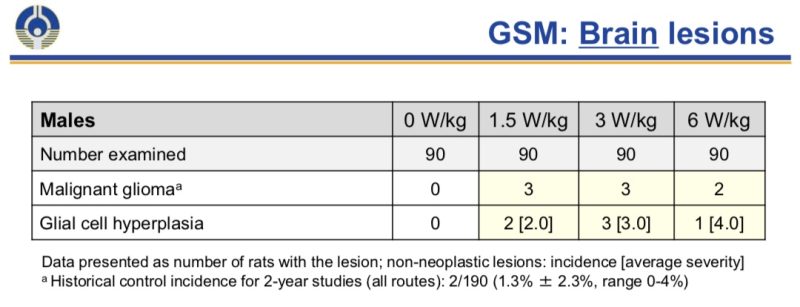
- NTP Study: Found that 1.5 W/kg exposure caused higher tumor rates than 6 W/kg exposure.
- Ramazzini Institute: Showed significant biological effects at exposure levels 1,000 times lower than the FCC’s limits.
- Jamaludin Study (2025): Found that a 4-hour exposure at Wi-Fi levels caused more sperm damage than an 8-hour exposure.
This completely contradicts the linear assumption behind SAR guidelines, making SAR an unreliable metric for safety.
Visualizing the Problem: SAR Data from RF Safe
To better understand how SAR fails as a safety measure, let’s examine real-world SAR data from RF Safe’s comprehensive comparison database. Each image below provides key insights into how SAR values vary across different phone models and how simultaneous exposure (Wi-Fi + Cellular) significantly increases RF absorption.
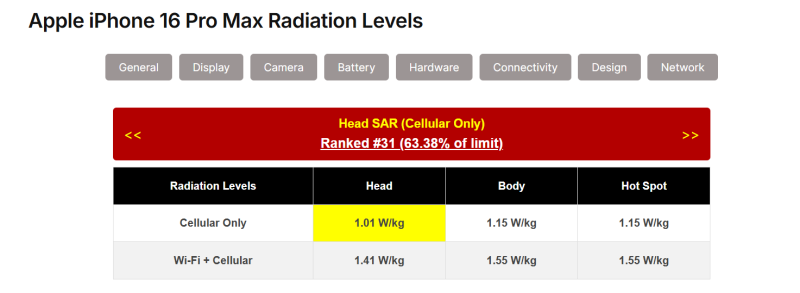
Apple iPhone 16 Pro Max SAR Levels
(Insert Image: SAR comparison table for Apple iPhone 16 Pro Max)
- Head SAR (Cellular Only): 1.01 W/kg
- Body SAR (Cellular Only): 1.15 W/kg
- Hotspot SAR (Cellular Only): 1.15 W/kg
When Wi-Fi is enabled, SAR levels increase dramatically:
- Head SAR (Wi-Fi + Cellular): 1.41 W/kg (28.1% increase)
- Body SAR (Wi-Fi + Cellular): 1.545 W/kg (25.6% increase)
- Hotspot SAR (Wi-Fi + Cellular): 1.545 W/kg (34.5% increase)
The RF Safe SAR Ranking System
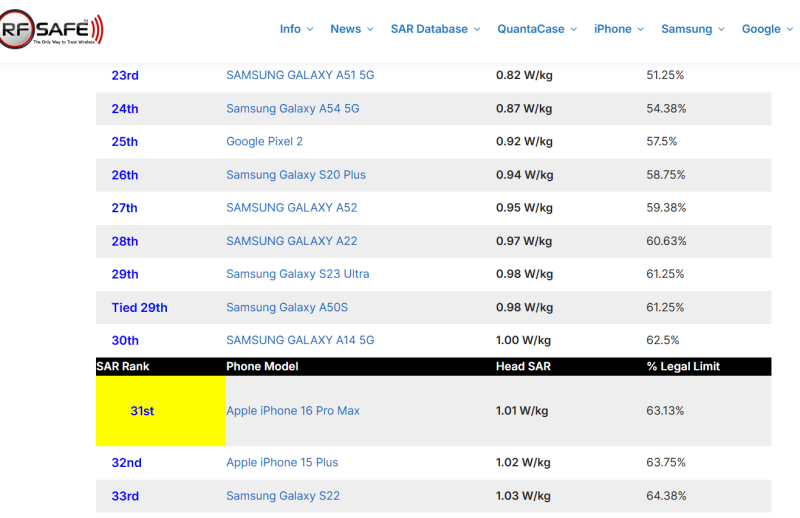
(Image: SAR ranking interface showing phone rankings based on radiation levels.)
RF Safe provides a ranking tool where users can compare SAR levels across multiple phones. This allows consumers to quickly assess which phones emit the highest and lowest radiation.
- Users can easily select and compare up to four different phones using an intuitive dropdown interface.
- The ranking system provides a clear, color-coded representation of each phone’s radiation levels, making it easy to visualize relative exposure risks.
- The rankings help identify which phones have lower SAR, but more importantly, expose how little SAR values truly reveal about real-world risks.
SAR Differences Between Children and Adults
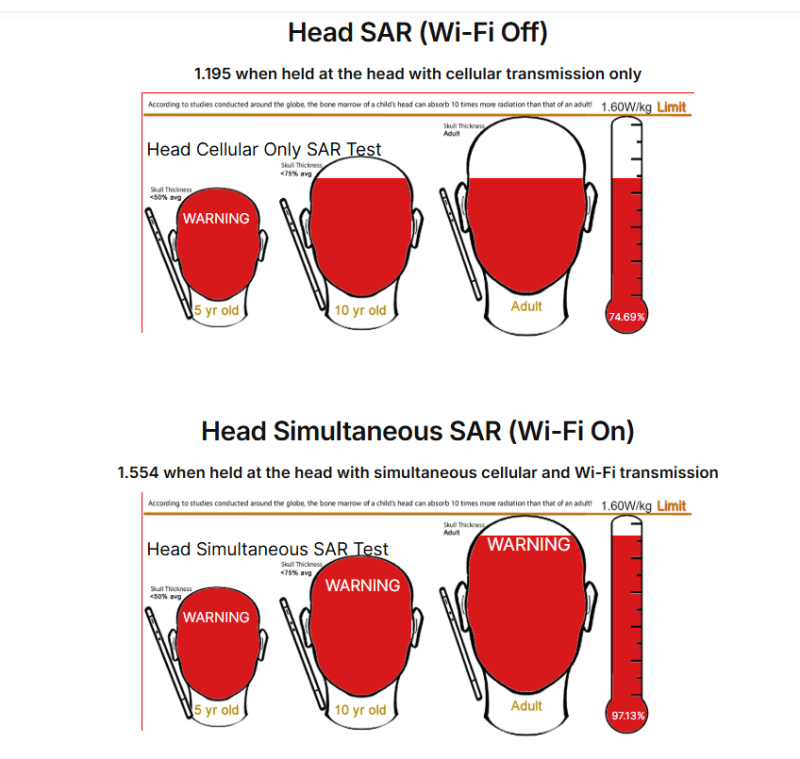
(Image: Comparison of radiation penetration in children vs. adults for head exposure with simultaneous transmission ON and OFF.)
- A 5-year-old child’s head is significantly smaller than a 10-year-old’s head, which is smaller than an adult’s head. This results in greater radiation penetration in younger children.
- The thinner skull and developing brain tissue in children allow more RF absorption compared to adults.
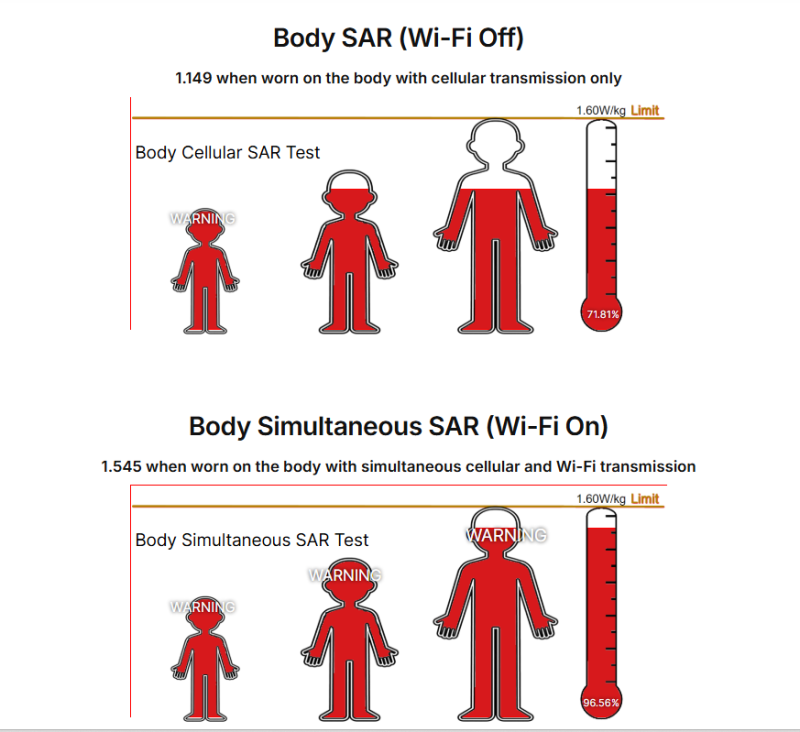
(Image: Comparison of radiation penetration in children vs. adults for body exposure with simultaneous transmission ON and OFF.)
- Children’s bodies absorb more RF radiation when carrying devices in pockets or against the skin.
- Turning Wi-Fi off significantly reduces exposure, but even then, children remain more vulnerable than adults.
How Much SAR Exposure Reduces When Turning Off Wi-Fi and Bluetooth
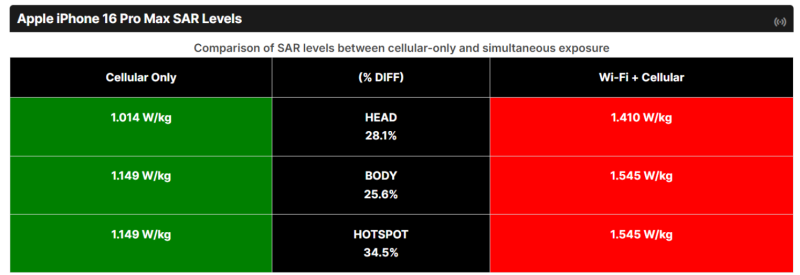
(Image: SAR reduction chart showing the difference in exposure when Wi-Fi and Bluetooth are disabled.)
This chart demonstrates how simply turning off Wi-Fi and Bluetooth can reduce exposure by up to 34.5%, giving users an easy way to minimize unnecessary radiation.
Standard Color-Coded SAR Comparison Charts
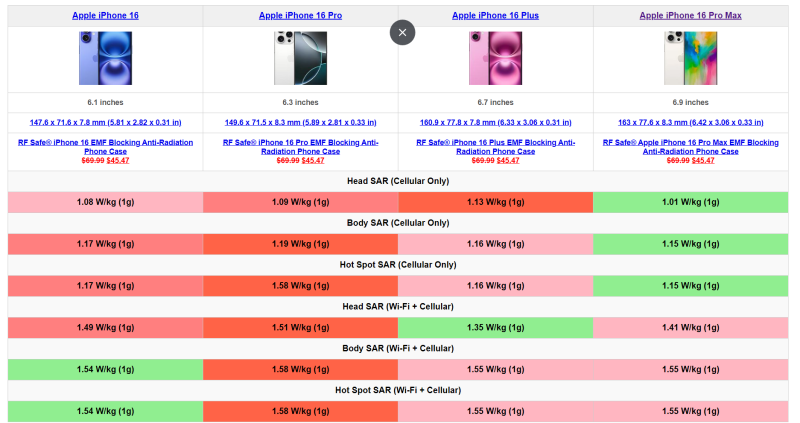
(Image: Color-coded comparison table showing SAR rankings for up to four different phone models.)
These visual comparisons allow users to quickly assess which phone models emit the highest and lowest radiation, providing an essential tool for informed decision-making.
Official FCC SAR Report for the iPhone 16e
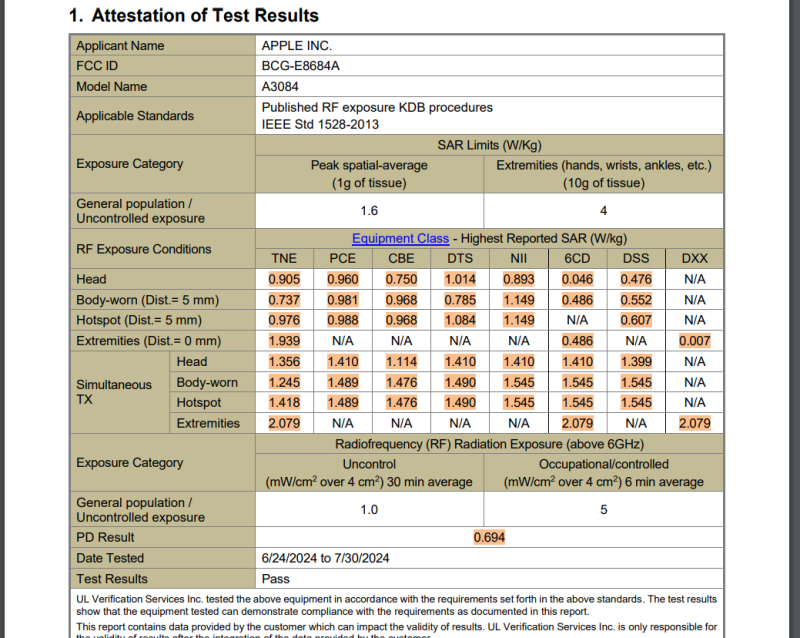
(Image: FCC’s official SAR test report for the iPhone 16e.)
This document highlights the official SAR levels recorded by the FCC, yet fails to account for non-thermal biological risks, reinforcing the flawed nature of current regulations.
SAR Summaries and Additional Charts
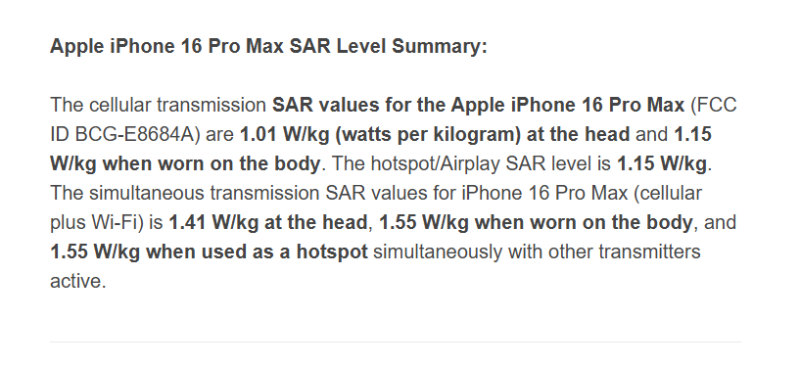
(Image: SAR summary charts detailing exposure levels across different testing conditions.)
These summaries compile key information, ensuring users have a clear and concise overview of each phone’s radiation emissions.
Taking Action: The Path Forward
SAR rankings exist because current regulations fail to address real risks. The real solution is:
🚨 Repealing Section 704 of the Telecommunications Act (1996) – Restoring the right of communities to challenge dangerous cell tower placements.
🚨 Updating FCC guidelines – Replacing outdated SAR standards with limits based on modern biological research.
🚨 Mandating safer alternatives – Pushing for Li-Fi (light-based wireless) and space-based broadband to eliminate toxic RF exposure indoors and near homes.
🚨 Reinstating government research – Restoring funding to the National Toxicology Program and enforcing Public Law 90-602 to continue investigating wireless health risks.
Final Thoughts: The SAR Illusion Must End
SAR values were designed to mislead the public into believing in a safety standard that has been scientifically disproven. While we provide SAR comparisons to help consumers navigate this deceptive landscape, the real goal is to push for truth and regulatory change.
SAR rankings help you find a lower-exposure phone—but they won’t make your phone safe. Only policy reform and technology shifts can do that.
The FCC’s guidelines are fraudulent. The science is clear. It’s time to demand real change and stop the SAR deception.